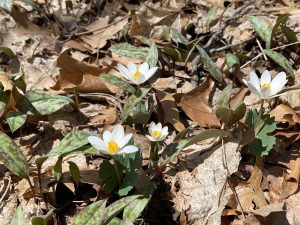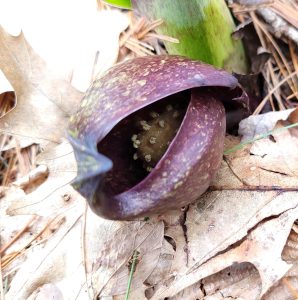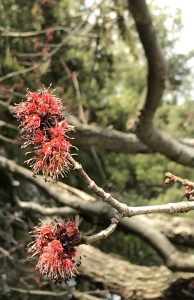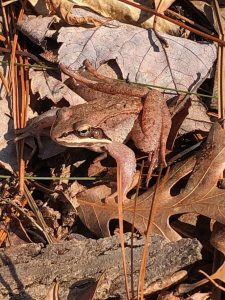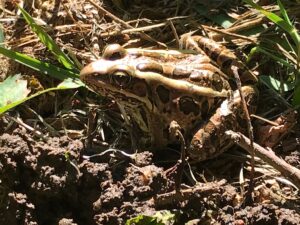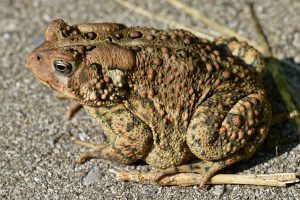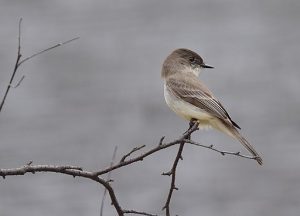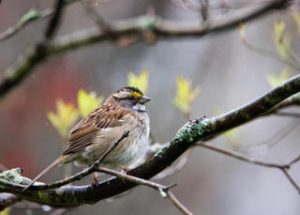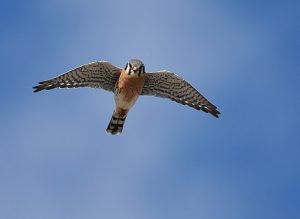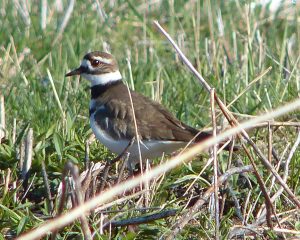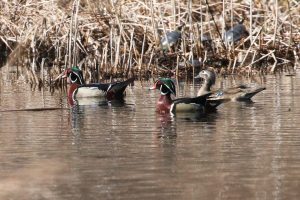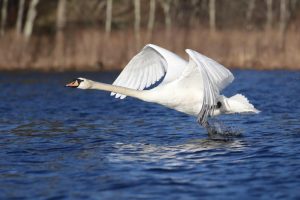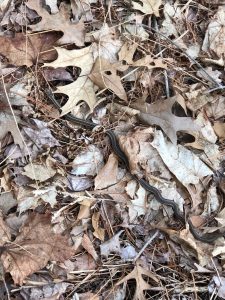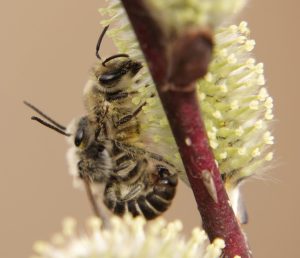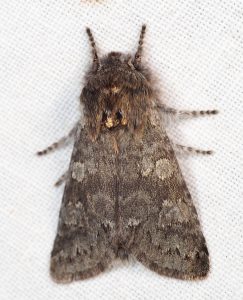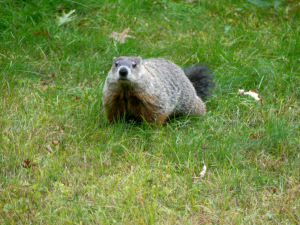Written by Gwyn Loud for the Lincoln Land Conservation Trust. She welcomes your sightings and questions at 781-259-8690 or gwynloud555@gmail.com.
March went out like a lion instead of a lamb, giving us what was hopefully our last snow on March 28, followed by several cold and windy days. If April showers bring May flowers, however, we can expect many blossoms next month. Already lawns and fields are green, and around homes forsythia and daffodils are giving a show. Many shrubs are leafing out and flowering red maples brush a red cast on the wooded landscape, with the flowers appearing before the leaves. Red maples are usually dioecious, meaning that male and female flowers are on different trees, but, according to naturalist Mary Holland, “Under certain conditions, a Red Maple tree can sometimes switch from male to female, male to both male and female (hermaphroditic), and hermaphroditic to female.”
In the woods look for flowering twin leaf and bloodroot and, in swamps and along streams, marsh marigolds’ bright yellow flowers. Skunk cabbage is flowering also, its globular flower half-hidden within the reddish curved spathe. Fern fronds are emerging from the forest floor with their characteristic fiddlehead shape and in the next few weeks woodland shrubs such as shadbush and spicebush will display blossoms. Garlic mustard is very visible now, so it is time once again to pull this invasive plant. The gardening season has begun; please consider environmentally friendly practices such as avoiding pesticides and herbicides, planting native plants, pulling invasives, and allowing some lawn areas to become meadows with wildflowers to attract butterflies and native bees. We can each play a part in promoting biodiversity and slowing climate change.
The amphibian migration to vernal pools happened over several wet nights in March and now wood frog and salamander egg masses can be found in the pools. The tiny spring peeper eggs (.06” diameter) are nearly impossible to find as many are laid singly. After mating and laying eggs, the adult wood frogs and spotted salamanders go back to their woods and upland homes. On any rainy night in spring amphibians may be on the roads, so please drive carefully. Soon we shall hear the high trill of American toads; their eggs are laid in shallow water in two twining strands of jelly, looking like necklaces of black pearls. Each strand can contain from 4000 to 12,000 eggs! If you hear what sounds like slow snoring you are hearing a Northern Leopard frog, and before long you may hear green frogs, gray tree frogs, and, lastly, American bull frogs. They each have their distinctive calls.
Birds are arriving from the south, some on their way to breed farther north and others to set up housekeeping here. Rusty blackbirds, a species in decline, were observed in swampy woods for a few weeks as they passed through and and a pair of American kestrels, another species in serious decline, has been seen for over a week at Drumlin Farm. We hope they stay to nest in a kestrel nesting box on a high pole. American woodcocks, as many as nine in one particular field, put on courtship displays at dusk. Presumably, some have mated and will be incubating eggs in well-camouflaged nests on the ground. Eastern phoebes, chipping sparrows, savannah sparrows, and tree swallows have returned, as have pine and palm warblers, the advance guard of wood warblers to come. Ruby-throated hummingbirds may turn up as early as the last week in April; anyone who puts out hummingbird feeders should be prepared. Bobolinks, which for years have been protected in Lincoln by delayed mowing of fields where they nest, should arrive in early May. Their 12,500 mile round-trip migration between summer breeding grounds and wintering sites in South American is one of the longest migrations of any New World songbird. We are lucky to have several fields where they breed in Lincoln. Other common songbirds which should arrive before the end of April include barn swallows, house wrens, and rose-breasted grosbeaks.
Birds of all species are singing and calling to attract mates and establish territories, and some have started nests. If you have an old wreath on your door you may find house finches as residents and some bluebirds have already laid eggs in bird boxes. Phoebes like to build on little ledges, often near houses and sheds. I found a small perfectly white eggshell along the road recently, evidence of an early mourning dove clutch. Killdeer are nesting on the ground in farm fields, and wood ducks will find tree cavities, often quite high, in which to raise their young. Years ago I happened to witness the fluffy young wood ducklings emerge from their nest hole about twenty feet high in the tree. They jumped to the ground one after the other, shook their down feathers, then paraded off single -file behind their mother for about a quarter-mile walk to the nearest pond. That was a precarious journey.
Ducks such as bufflehead, mallards, ring-necked ducks, common mergansers and hooded mergansers have been on various ponds, including Flint’s Pond, Walden Pond, and Valley Pond. Wood ducks are quite secretive, and prefer secluded ponds and swamps. An astonishing number of mute swans (18) have turned up on Farrar Pond, the most ever seen there. It remains to be seen how many will stay and actually raise young. Another unusually high number (13) came in a report of an unkindness (yes, the correct word!) of common ravens flying over Drumlin Farm. Ravens have been proliferating in the Metro-West area and at least one pair has nested in Lincoln in recent years.
Reptiles, being coldblooded, need warm weather to get them moving. Painted turtles spend hours basking in the sun on branches in ponds and observers have reported garter snakes, moving slowly if the air is chilly. With rising temperatures, insects are also becoming more active and Norm Levey has continued to photograph insects we may overlook. Wild bees, including cellophane bees and mining bees are out, and he saw the first bumblebee, Bombus perplexus on April 11. Since insects are essential to food chains and our eco-systems, I have to remember to be grateful for a few mosquitoes at a picnic. Caterpillars are very important food for baby birds as they are soft and digestible, another reason to welcome them. If you come across a fuzzy brown cocoon you have found the pupa of a woolly bear caterpillar. Unlike most Lepidoptera, this caterpillar overwinters as a larva and spins its cocoon in the spring. Soon it will hatch into an Isabella tiger moth. Tick season is here so be sure to check for them after being out in woods and fields.
As for mammals, woodchucks, one of only a few true hibernators, have woken up and white-tailed deer are much in evidence, as always. During the winter the deer fed on woody plants and a neighbor tells me they feasted on all her holly bushes. Now is when year-old bucks start growing antlers. Beavers are active in many places, including a pond on Winter St. where the Town has placed a ‘“beaver deceiver” to allow the beavers to carry on making a dam, while preventing the water from flooding the road.
Some observers report fewer chipmunks than usual this year; the decline is a mystery. On a positive note, a river otter has moved into the swamp/pond area behind Matlock Farm.
April 22 is Earth Day! Please check out the LLCT and Town Conservation Dept. websites to find out how you can help and join the celebration. You could bring a great close to the day by watching the Lyrid meteor showers put on their annual display.
© Gwyn Loud


